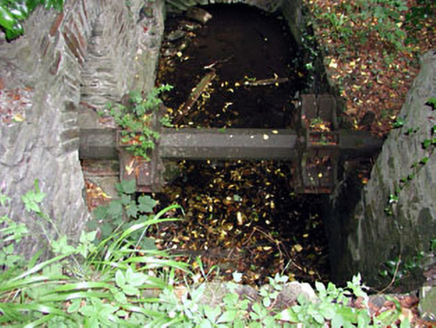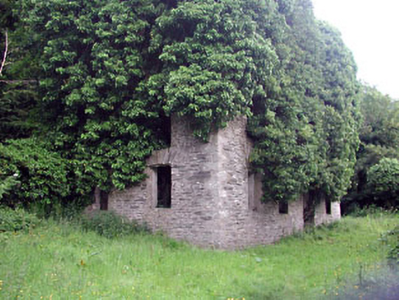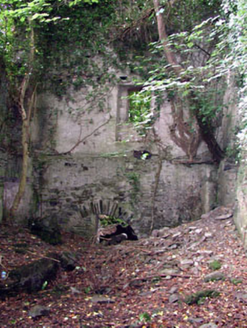Survey Data
Reg No
11820044
Rating
Regional
Categories of Special Interest
Architectural, Technical
Original Use
Mill (water)
Date
1800 - 1805
Coordinates
292927, 209886
Date Recorded
07/01/2003
Date Updated
--/--/--
Description
Mill complex, built 1802, on a triangular plan about a courtyard including (south): Attached six-bay four-storey mill on a rectangular plan. Closed, 1914. Now in ruins. Pitched roof now missing with no rainwater goods surviving on cut-limestone eaves. Overgrown lime rendered coursed rubble stone walls. Square-headed window openings with overgrown dressings framing twelve-over-eight timber sash windows. Interior in ruins; (north): Detached four-bay (two-bay deep) three-storey mill with half-attic on a rectangular plan. Closed, 1914. Now in ruins. Hipped roof now missing with no rainwater goods surviving on cut-limestone eaves. Overgrown coursed rubble stone walls with concealed rough hewn granite flush quoins to corners. Square-headed window openings in camber-headed recesses with fittings not visible. Interior in ruins. Set in overgrown grounds.
Appraisal
A mill complex representing an important component of the industrial heritage of County Kildare. NOTE: The history of milling at Ballymore Eustace can be traced back to the twelfth century and Archbishop Alen's Register states that Archbishop John Comyn (d. 1212) derived income from mills at Ballymore Eustace and elsewhere. The mill is likely to have been destroyed in the sixteenth century, a report (1572) to the Lord Deputy stating that 'Irish rebels had burned all Ballymore except Mr. Le Strange's house and castle', but almost two centuries later a mill was shown on the map of County Kildare produced (1752) by John Noble and James Keenan. The mill was subsequently purchased (1802) by Christopher Drumgoole (d. 1842) and was adapted for the production of wool but, initially successful, was impacted by the reopening of shipping lanes in the aftermath of the Napoleonic Wars (1803-15). The mill was described by Samuel Lewis (1837) as employing about 700 people 'when in full work' and was described by John S. Sloan (1838) as 'idle and deserted'. A brief revival came about under Peter Dromgoole (d. 1848) who, according to family papers, 'erected and fitted up an oatmeal mill adjoining the factory...erected or improved the dwelling house...and is said to have expended upwards of £2000 on the premises'. Ownership of the complex eventually passed to John Copeland (d. 1879) and, on his death, to Henry Lewis Copeland (d. 1903) who exhibited woollen goods at the Irish Exhibition held at the Rotunda in Dublin (1882) but Ballymore Eustace Woollen Mills was in terminal decline: production ceased in 1914 and most of the machinery was removed in 1924.





